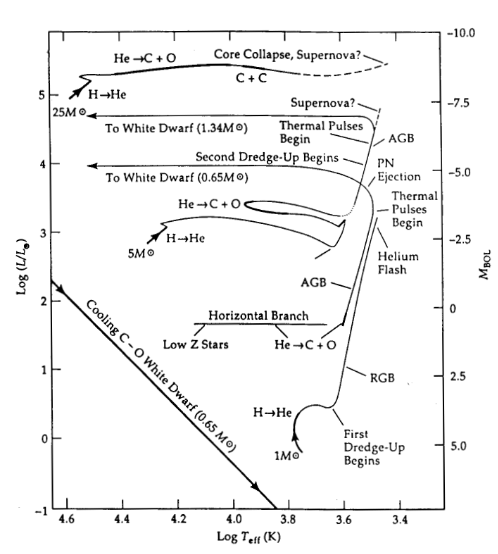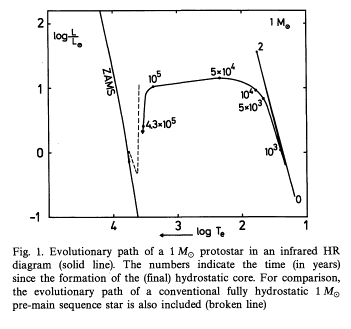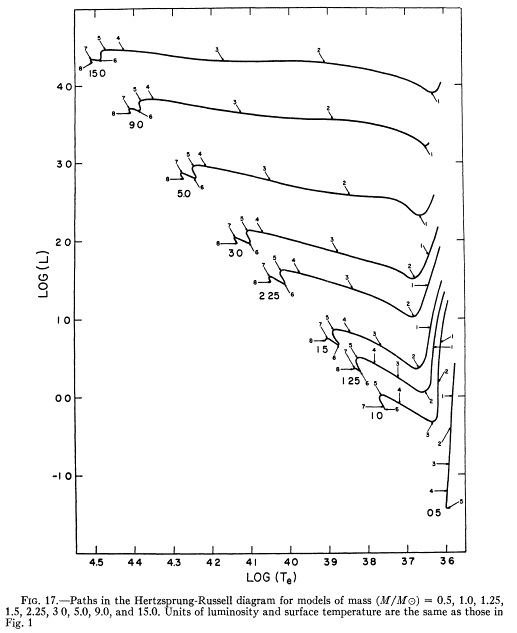The turns in the
PMS evolutionary paths in the diagram above are due to changes in the structure
of the core of the star as it adjusts, fitfully, to nuclear burning in
the core. The diagonal line joining the "8"s in the figure is called
the Zero-Age Main-Sequence (ZAMS),
and represents the point at which equilibrium nuclear burning of H to He
is taking place. When the star arrives on the ZAMS, it has transitioned
from a PMS object to a true star. We already saw that stars evolve
slightly after reaching the main sequence, when we discussed the evolution
of the Sun over its lifetime. The track is a slight motion along
the main sequence, upward and to the left as the luminosity increases.
Hydrogen Core Burning
This stage of a star's life
lasts for a time proportional to its mass, roughly according to the relation
where tsun
= 10 billion years. This is the total time spent on the main sequence
(the main-sequence lifetime).
Hydrogen Shell Burning
As the star uses up its
initial supply of H in the core, it begins to collapse again and the temperature
and density in a region around the core (a shell) reaches high enough temperature
to ignite H. This causes the star to expand and leave the main
sequence, rising up the Red Giant Branch (RGB).
During this time, the He in the core is inert, and for sufficiently massive
stars it grow denser until it becomes electron
degenerate.
Helium Core Burning
Once the star exhausts its
supply of H in the shell, the star again collapses and the temperature
rises rapidly. The dense core of Helium suddenly reaches ignition
temperature (Helium flash) and the track discontinuously changes to lower
luminosity as the star shrinks again from its RGB stage. Once there,
it again is stable, on a "helium main-sequence", but its lifetime in burning
He is much shorter than before.
Helium Shell Burning
When the He is exhausted
in the core, the star begins to burn He in a shell around the Carbon core,
and the track again moves to a red giant stage along the Asymptotic
Giant Branch (AGB). Because of the temperature dependence
of He burning, the star is unstable during this stage and thermal
pulses begin, which causes the ejection of planetary
nebula (PN).
Carbon Burning
More massive stars can repeat
this scenario with collapse to a stable carbon burning stage, again with
ever shorter lifetime.
End of Life
Stars of various masses
behave differently in detail, but ultimately they all suffer the same fate
of collapse due to the available nuclear fuel being exhausted. In
the case of stars like the Sun, He burning is the last stage. For
less massive stars, He burning may not take place at all. Once the
final collapse takes place, we have only to look at the violence of the
collapse and the forces involved to determine what happens next.
-
White dwarf is the fate
of solar mass stars, after the PN stage removes all of the outer layers
of the star, leaving only a bare carbon core that slowly cools.
-
Neutron star is the fate
of more massive stars, which are greater than 1.4 solar masses (after the
loss of their outer layers).
-
Black hole is the fate
of stars of more than 3 solar masses (after loss of mass in PN stage).


